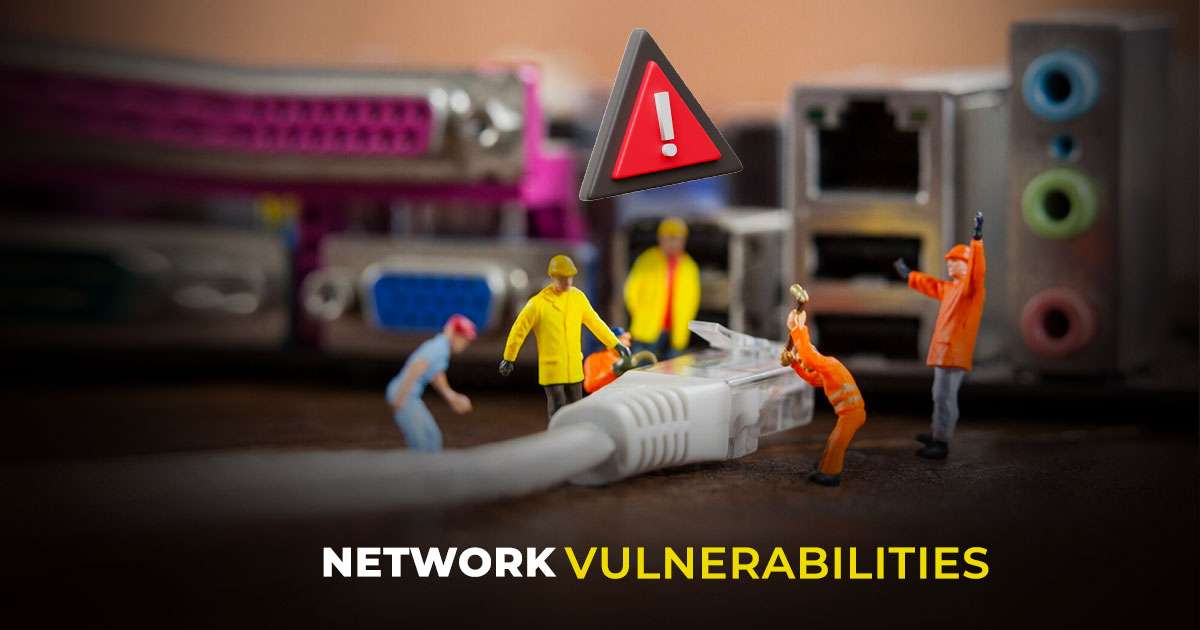Network Vulnerabilities: Guide to the Most Common Threats and Protection Measures

With the rate at which technology is developing these days, the internet has become an essential component of daily life. The way we shop, communicate, learn, and pass the time has all been completely transformed by it. Despite the fact that there are unquestionably many advantages to the internet, there are also certain risks involved.
According to a study by Pew Research Center, a significant number of internet users are not aware of the basic tenets of digital security and often leave their data vulnerable to breaches . This calls for a heightened sense of responsibility among all internet users. One key aspect of this is understanding the concept of Network Vulnerability.
What is Network Vulnerability?
Network vulnerabilities are holes or weaknesses in a computer network that can be used to initiate cyberattacks or obtain unauthorized access. These vulnerabilities can arise due to a variety of factors, ranging from outdated software and weak passwords to insecure wireless networks and human errors. In most cases, the responsibility for these vulnerabilities lies with both the users and the administrators of the network.
Cyber attackers exploit these vulnerabilities to disrupt network operations, steal sensitive data, or execute malicious codes. These attacks may be carried out for a variety of reasons, ranging from espionage and money gain to just wreaking havoc. It is essential to comprehend the typical categories of network vulnerabilities in order to defend against these threats.
Top 10 Common Network Vulnerabilities and Their Mitigation
There are several common network vulnerabilities that users should be aware of. Cybercriminals may be able to access a network without authorization by using any one of these vulnerabilities.
Weak Passwords
Weak passwords are one of the most common network vulnerabilities. With brute force attacks, in which an attacker tries various password combinations until they find one that works, they are easily cracked or guessed. It is crucial to create strong, one-of-a-kind passwords that incorporate special characters, numbers, and letters in order to lessen this. To create and safely store complicated passwords, think about utilizing a password manager.
Outdated Software
Unpatched security holes in outdated software are frequently present, which hackers can use to enter your network without authorization. Regularly updating your software and applying patches as soon as they’re available is crucial for protecting against this vulnerability. To guarantee that your software is always up to date, turn on automatic updates whenever you can.
Insecure Wireless Networks
An easy point of entry for attackers can be found in insecure wireless networks, like public Wi-Fi networks. To protect against this, always connect to secure networks whenever possible and utilize VPNs when connecting to public Wi-Fi networks. By doing this, you can conceal your online activity from possible attackers and encrypt your internet connection.
Poor Access Control
Unauthorized users may gain access to sensitive data as a result of lax access control. To avoid this, use strong access control measures such as two-factor authentication and role-based access control. This ensures that only authorized users have access to specific areas of your network.
Unencrypted Data
Unencrypted data can be easily read if intercepted during transmission. Encrypt sensitive data by converting readable data into coded data that can only be read with a decryption key.
Lack of Regular Audits
Potential network vulnerabilities may go undetected if regular audits are not performed. Regular audits can help identify these vulnerabilities before they’re exploited. Use vulnerability scanning tools and consider hiring a cybersecurity professional to conduct thorough audits.
Social Engineering Attacks
Social engineering attacks take advantage of human error rather than technological flaws. Phishing attacks, for example, trick users into disclosing sensitive information. To guard against this, train your employees to recognize and avoid such attacks.
IoT Devices
Many IoT devices lack robust security measures, making them a prime target for cybercriminals. Protect your network by ensuring all IoT devices connected to it have strong security measures in place. They should keep their software up to date and use strong, unique passwords for each device.
Mobile Devices
Mobile devices used in BYOD (Bring Your Own Device) policies can be easy targets for attackers, especially if they’re lost or stolen. Protect these devices by implementing mobile device management solutions that allow you to track, lock, or wipe lost devices remotely.
Shadow IT
Shadow IT refers to systems, applications, or services that have been installed without the permission of the IT department. These can pose significant security risks because they are not always subject to the same security controls as authorized systems. Prevent the use of shadow IT by implementing strict IT policies and educating employees about the risks.
Securing Your Network: A Guide for Internet Users
It is now more important than ever to ensure the security of your network. Here are some steps you can take as an internet user to protect your network.
Use Strong and Unique Passwords
Using strong and unique passwords is one of the most basic ways to secure your network. This decreases the likelihood of unauthorized access through brute force attacks. To generate and store complex passwords, consider using a password manager.
Keep Software and Devices Updated
Keep your software, operating systems, and devices up to date. Because updates frequently include patches for known security vulnerabilities, keeping everything updated lowers the likelihood of attackers exploiting these vulnerabilities.
Install a Reliable Security Suite
Install a trustworthy security suite with antivirus and anti-malware protection. This aids in the detection and removal of malicious software before it causes harm.
Use a Firewall
Based on predefined security rules, a firewall monitors incoming and outgoing network traffic. In order to prevent malicious traffic such as viruses and hackers, it creates a barrier between your internal network and incoming traffic from external sources (such as the internet).
Secure Your Wi-Fi Network
Change your Wi-Fi network’s default name and password, and enable WPA3 (Wi-Fi Protected Access 3) encryption if it’s available. Consider creating a guest network for visitors to avoid them accessing your main network.
Beware of Phishing Attempts
Be wary of emails, text messages, and websites that request personal information. Always check the source before clicking on any links or providing any personal information.
Regular Network Audits
Regularly audit your network for potential vulnerabilities. Use network scanning tools or hire a cybersecurity professional to conduct these audits.
Educate Yourself and Others
Keep up to date on the most recent cybersecurity threats and best practices. Also, educate your family members or coworkers, as they can inadvertently become a weak point in your network’s security.
Use a VPN
A Virtual Private Network (VPN) encrypts your internet connection, making it more difficult for hackers to intercept your information.
Backup Your Data
Backup your data on a regular basis, whether locally or in the cloud. You will be able to restore your data from these backups in the event of a breach.
Empowering Internet Users Through Enhanced Network Security
The world of the internet can be a minefield of potential threats and vulnerabilities. However, by understanding these common network vulnerabilities and taking proactive steps towards securing your network, you can navigate this landscape with confidence.
By implementing strong and unique passwords, keeping software updated, installing a reliable security suite, using a firewall, securing your Wi-Fi network, being cautious of phishing attempts, conducting regular network audits, educating yourself and others, using a VPN and regularly backing up your data, you can significantly enhance your network’s security.
This not only protects your sensitive data from potential breaches, but it also lowers your risk of being a victim of cyber threats. In this digital age, equipping yourself with the knowledge and tools to safeguard your network is an absolute necessity.
Remember that network security is a continuous process, not a one-time task. Stay alert, stay current, and most importantly, stay safe. Here’s to a safer internet experience for all!

